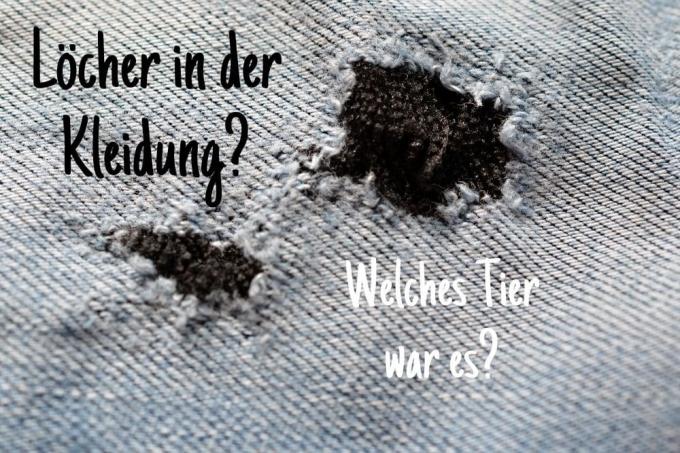
table of contents
- Gluttonous moths and bugs in the closet
- Clothes moths (Tineola bisselliella)
- Carpet beetle (Anthrenus scrophulariae)
- Fur beetle (Attagenus pellio)
- Fur moth (Tinea pellionella)
- Brass beetle (Niptus hololeucus)
- Prevent moth or beetle infestation
- frequently asked Questions
Small holes in beloved clothes are very annoying. If they are discovered (pitting), small animals are the main suspects, so-called textile or material pests such as moths and beetles. But who exactly are the culprits?
In a nutshell
- Holes in clothing, evidence of textile pests
- First signs of dead or living insects, mostly near the window
- Access via nest boxes close to the house, bird, bee, Wasps- and squirrel nests into the house
- Combating is often difficult and tedious
- The most common textile pests are clothes moths, fur and carpet beetles
Gluttonous moths and bugs in the closet
An infestation with moths and bugs in the closet is not that rare and can occur even in the cleanest household. The larvae of textile or material pests mainly target animal fibers. Modern synthetic fibers and cotton are largely spared. Moths or beetles are usually content with nectar and pollen and migrate from the outside in the warm season. In addition to clothes moths, fur and carpet beetles, fur moths and brass beetles are also worth mentioning. But how can you tell which animal it is?
Clothes moths (Tineola bisselliella)
The moth itself has a body length of four to nine millimeters and a wingspan of 12-16 mm. It lives two to three weeks and occurs increasingly between May and September. Damage is only caused by the larvae, four to nine millimeters in size, yellow-white caterpillars.
Clothes moths can be found in warm, dry and dark places, for example in the wardrobe, and tamper with items of clothing, furs, carpets and other textiles. A possible infestation can u. a. by the empty webs that the larvae build from the textiles.
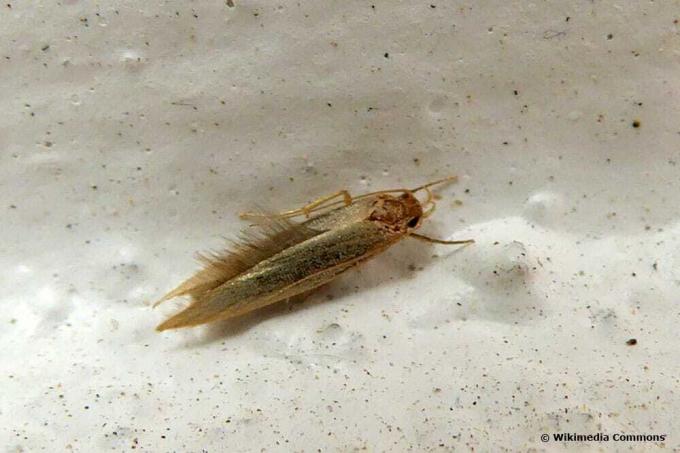
Tip: When you first suspect an infection, you should check which pest you are dealing with. For example, with the help of glue traps, with the help of the feeding marks or where eggs, larvae or webs are located.
Damage and control
The larvae of this moth eat holes and bald spots in wool, silk or leather. In the case of mixed fabrics, they each deal with the wool content. Holes caused by the clothes moth have very irregular edges. The fibers around the holes appear to have been cut off. Fragrances can help keep individual moths out of the closet. If there is an infestation, however, it is usually too late for fragrances. It is better to sort out the affected items of clothing quickly.
- Dispose of contaminated clothing in plastic bags with household waste
- Still usable, wash at at least 60 degrees
- Heat sensitive for 24 hours at at least minus 18 degrees in the freezer
- Alternately expose non-washable textiles to extreme heat and cold
- Or in direct sunlight for a while
- Eggs and larvae dry out and die
- In case of severe infestation, additional use of parasitic wasp (Trichogramma evanescens)
- The use of the plant extract neem is also recommended
- Can stop the development of insect larvae
- Thoroughly clean the wardrobe, especially all corners and cracks
Tip: To control the infestation, it is advisable to set up pheromone traps after the control. They are not suitable for direct control, at best for reducing infestation.
Carpet beetle (Anthrenus scrophulariae)
In this three to four millimeter large animal, too, it is the larvae that cause the damage. They are approx. five millimeters tall, blackish brown with white rings and very hairy. They often sit between floorboards, where they also feed on hair and flakes of skin. Carpet beetles can come into the house to lay their eggs between May and June.
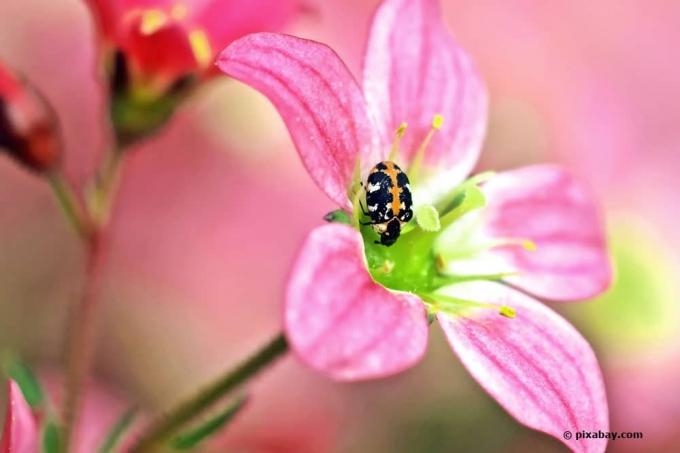
Tip: The so-called arrow hairs can trigger allergies in sensitive people. They can cause allergic reactions in the skin and respiratory tract.
Damage and control
the Larvae leave similar holes in woolen textiles like the clothes moth. However, the characteristic webs are missing here. If the textiles in question are contaminated with sweat or leftover food, this will pull them Pests additionally.
- First determine the extent of the infestation using sticky traps
- Thorough vacuuming of cupboards, chests, etc.
- Dispose of contaminated clothing as already described, wash or freeze
- Store clothes that are not required for a long time in sealable bags
- Combat with neem oil or mineral powder preparations
- Small sharp-edged particles made of natural silica or finely ground diatoms
- Lay powder on the animals' hiding places
- Pests have to come into contact with it
Tip: Combined preparations made from insecticides and essential oils are available in stores. However, they should only be used for control and not as a preventive measure.
Fur beetle (Attagenus pellio)
The fur beetle is one of the most common pests in German wardrobes. A distinction is made between the brown, 2.3 to 4 mm long fur beetle with a darker head and pronotum and the 5.5 mm long spotted beetle. It is dark red-brown to black with lighter elytra, three white hair spots on the neck and another on the head.
The larvae of the brown fur beetle are about seven millimeters long, golden yellow to light brown and covered with scale bristles. The bristle tail sits at the rear end. The spotted fur beetles are very hairy, light to dark brown and about nine millimeters long. At the rear end they have long, golden to bronze colored hair.
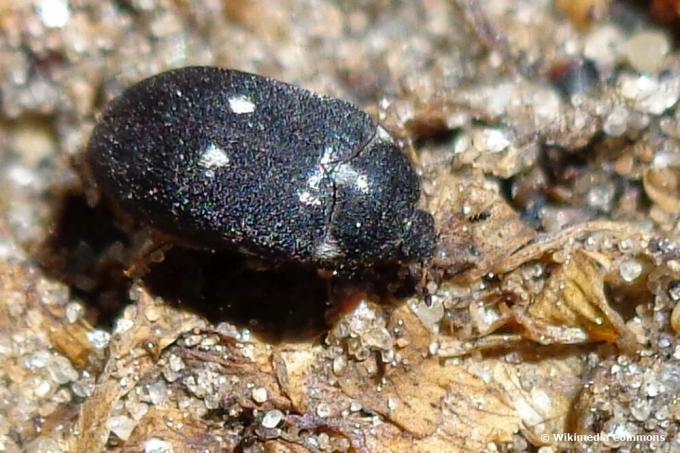
Damage and control
Fur beetle larvae are very voracious and can cause great damage to textiles. In less thick tissue they eat sharply rimmed holes with an irregular outline. In thicker, velor-like fabrics, there are signs of eating only on one side. The areas look like shaved afterwards. In contrast to the clothes moth, the webs are missing. If you look closely you can see the typical larval skins. The control is similar to that of the clothes moth and the carpet beetle.
Fur moth (Tinea pellionella)
This animal looks very similar to the clothes moth, but occurs mainly in damp and poorly heated apartments. Because of this, it is much rarer in this country than the clothes moth, for example. The moth grows up to six millimeters in size, has yellowish wings with three to four black dots and a wingspan of 9 to 13 mm.
The white-yellow larvae have a brown head and are up to ten millimeters in size. They live in a so-called quiver that they have woven themselves and carry around with them. The fur moth also loves textiles containing keratin, but does not disdain food either. It is often brought into one's own home with imported goods.
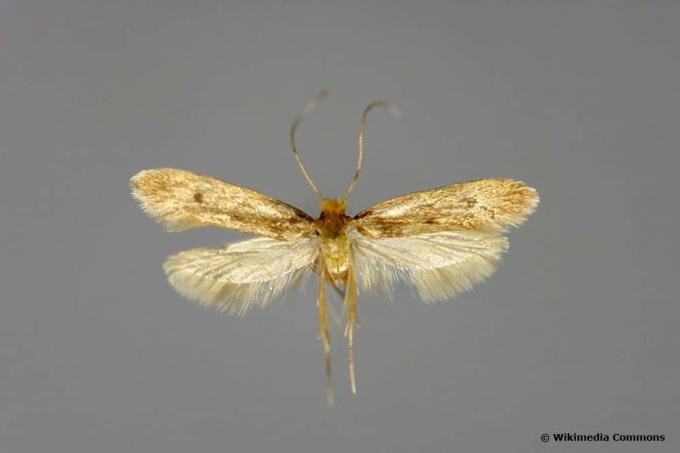
Damage and control
In addition to pitting in clothing and other textiles, they also attack animal and vegetable foods. As a result, you shouldn't suspect them to be exclusively in your wardrobe. Often you can also find the quivers or their remains.
- Sort out contaminated clothing
- Freeze for several weeks, wash at 60 degrees or dry-clean
- Use the killing effect of the sun
- Same procedure with nearby textiles
- Only wipe the cupboards with a damp cloth if it is dry
- Use parasitic wasps if necessary
- Use the scents of lavender flowers and cedar wood as well
Brass beetle (Niptus hololeucus)
Brass beetles are spider-like-looking, flightless, 2.4-4.7 mm large insects with dense, shiny brass-colored hairs on the wing covers. Their antennae are remarkably long. The up to 7.5 mm large larvae are whitish-yellow with a brownish-yellow head capsule. A red vertical line can be seen on both sides of the head.
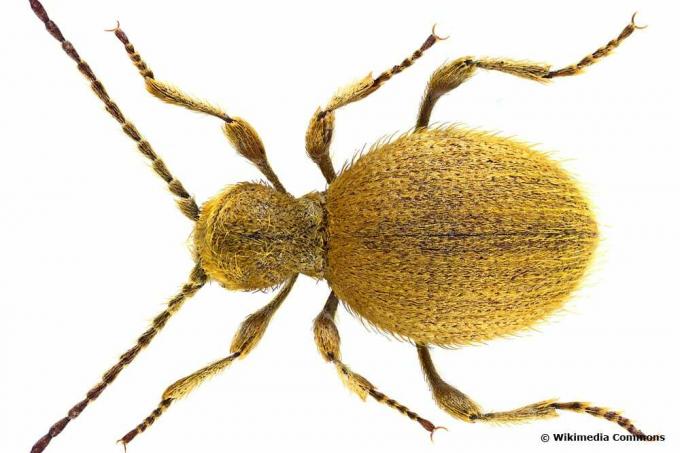
Damage and control
In contrast to the other textile pests, the type of food in beetles and larvae is similar, with the fully developed beetle being the main pest. As a result, the extent of the damage in the form of feeding holes is much greater. The breeding grounds can be in false ceilings with organic insulating materials, in cavities in the ground or in other places that are difficult to access. This makes it difficult to find and control, so there is no getting around the help of a professional pest controller.
Prevent moth or beetle infestation
- Attach mosquito nets to windows and doors
- Check clothing repeatedly for infestation
- If necessary, lay out glue traps
- Keep especially valuable things in garment bags
- Also applies to items of clothing that are not required for a long time
- Wash and air things regularly
- Ventilate rooms and cupboards every now and then
- Thoroughly clean voids in floors and ceilings and cracks in closets
- Use deterrent scents
- Are scented lavender, Cedar wood, clove spice, bay leaves, peppermint and patchouli
frequently asked Questions
It spreads very quickly. Hatched moths only have a short lifespan, but reproduce several times during this time.
Ichneumon wasps are a natural means of completely controlling moth populations, provided that they have not become rampant. This takes them between three and six weeks.
Above all, it is important to combat it at an early stage and across the board. Not to forget the pre- and post-operative care.
